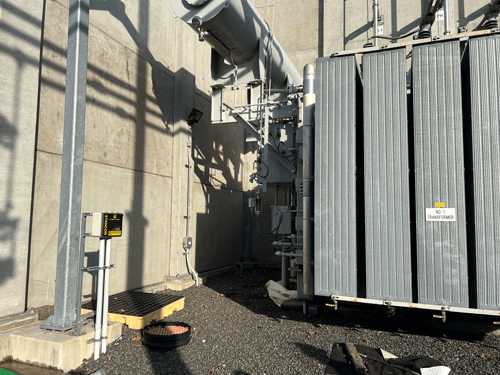
Electrical transformers, breakers and reactors all use substantial volumes of specialized mineral or synthetic oil as insulation and coolant. Keeping such large quantities of oil contained is a top priority for utility companies and equipment manufacturers. Risks to the environment and employees, along with potentially significant legal liability, give utilities incentives to invest in spill prevention measures.
Despite these efforts, oil spills do happen. Equipment failure is a common cause, but human error, natural disasters and acts of vandalism all contribute to the problem.
Spillage should be contained in a moat or sump pump, but if those fail, oil can contaminate the surrounding communities and adjacent waterways. Chemical exposure can cause environmental damage and public health risk, resulting in expensive restoration and legal liability. System downtime and service interruption only add to the potentially immense
costs of cleanup.
Secondary oil containment systems designed to capture and contain spills mitigate these risks and have become essential to electric utility infrastructure. Advanced systems immediately detect spills and actively transmit live data from pumps to monitoring networks. Conductive sensing devices attached to pumps trigger automated alarm systems that alert operators of system faults caused by oil spills.
Alternatively, operators can proactively ping devices to verify system reliability. Critical parameters such as oil temperature, oil level and pump status are monitored on-site or relayed from unmanned substations to supervisory control and data acquisition (SCADA) terminals, permitting remote real-time monitoring from centralized locations. The cloud-based connectivity of this system allows for the continuous oversight that helps prevent disastrous oil spills.
This innovation is an example of the industrial internet of things (IIoT), the integrated network of machines, sensors and devices that communicate data in industrial systems. Similar to consumer IoT (CIoT) technologies found in smart home systems, IIoT enables continuous real-time monitoring and informed analysis of industrial processes.
IIoT Offers Utilities Insight & Control
IIoT offers a wealth of data critical for grid management and demand response, outage identification and user consumption patterns. For electric utilities, IIoT addresses several challenges at once. It provides unstrained access to granular data about a facility’s equipment in real time, facilitates automated emergency response protocols and centralizes information where the most qualified employees can keep tabs on operations from a central location.
IIoT has uses far beyond spill prevention. Utilities are using the data generated by IIoT systems to gain insights into consumption and operation patterns on a system-by-system basis. Engineers use this data to optimize the efficiency of systems and schedule routine maintenance around actual market demand. At the grid level, analytics tools combine IIoT data with upstream information about wind and solar generation, helping utilities fine-tune their systems for energy supplies from renewable sources.
IIoT also offers important contributions to regulatory compliance efforts like monitoring operations and energy usage
in real time and quickly reporting efforts to mitigate environmental and safety hazards. Companies also reduce their environmental footprint and energy usage by identifying weaknesses and inefficiencies. IIoT’s role in spill prevention highlights the technology’s potential to drive value for utility companies at the local level. Consider these points:
Nimble risk prevention: Real-time alerts and data on equipment health enable companies to promptly identify potential issues and quickly make informed decisions that can prevent breakdowns
and accidents.
Predictive maintenance: Using real-time data, predictive maintenance systems identify maintenance requirements, increase equipment reliability and reduce inefficiencies and failures.
Safety: Active systems can monitor hazardous materials and processes. The additional layer of oversight and control over critical systems can substantially reduce health and safety risks.
Robust compliance: IIoT makes regulatory compliance easier by centralizing historic data. These systems reduce the potential for human error, ensuring more accurate and timely reporting. After a spill event occurs, the utility can leverage its data insights to rapidly and reliably diagnose and document root causes.
Future-ready agility: Electric utilities must be able to respond to change, both in aging equipment and emerging technology. IIoT is destined to develop rapidly with technical innovation and expanded applications. New investment will undoubtedly motivate this transformation of industry.
Overcoming Challenges of IIoT Implementation
At the facility level, IIoT solutions can be relatively easy to implement thanks to the reliability and low cost of
networked devices. Many components in utility systems, like pumps and switches, can be retrofitted with sensors and transmitters to feed into a company’s IIoT infrastructure.
Companies can benefit from the technology without a full implementation of elaborate data analytics tools. Nevertheless, installing and operating IIoT solutions requires careful consideration of the technology’s potential shortfalls.

